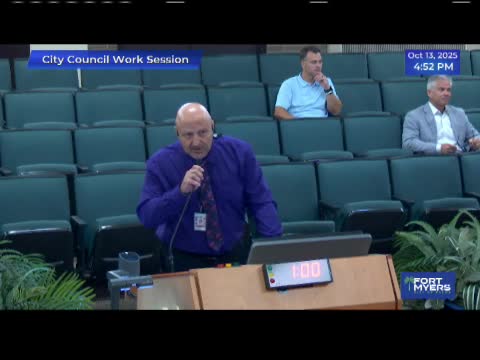Council weighs Army Corps CAP‑103 feasibility study and FEMA downtown resiliency grant; staff sees tradeoffs
October 13, 2025 | Fort Myers City, Lee County, Florida
This article was created by AI summarizing key points discussed. AI makes mistakes, so for full details and context, please refer to the video of the full meeting. Please report any errors so we can fix them. Report an error »

Public Works staff briefed council on two shoreline resilience opportunities: re‑engaging the U.S. Army Corps of Engineers under a CAP‑103 feasibility study and moving forward on a FEMA hazard mitigation award for downtown seawall design and construction.
Director Pete Bennett said the CAP‑103 route would advance a long‑term federal partnership but requires a city match of $450,000 for the feasibility study and carries schedule and funding uncertainty tied to federal review and appropriations. The Corps study could take roughly two years, and any resulting construction could take three to five additional years. Bennett cautioned the Corps' staffing turnover and uncertain federal funding availability increase schedule risk.
By contrast, staff said the city has a FEMA‑approved downtown resiliency grant (the presentation cited a total cost of about $3.63 million, with a federal share of $2.72 million and a local share of roughly $907,000) and that the local match is covered by post‑Ian HUD/CBDBG hurricane funds. Council members discussed whether to pursue CAP‑103 while also implementing the FEMA project; some members recommended doing both — FEMA for near‑term protection and CAP‑103 for longer‑term planning — but staff highlighted the financial and schedule risks of the Corps option and noted the certainty of FEMA funding for near‑term downtown work.
No formal vote was recorded; council signaled support for advancing the FEMA program and directed staff to continue Corps discussions while clarifying risks and potential sequencing.
Director Pete Bennett said the CAP‑103 route would advance a long‑term federal partnership but requires a city match of $450,000 for the feasibility study and carries schedule and funding uncertainty tied to federal review and appropriations. The Corps study could take roughly two years, and any resulting construction could take three to five additional years. Bennett cautioned the Corps' staffing turnover and uncertain federal funding availability increase schedule risk.
By contrast, staff said the city has a FEMA‑approved downtown resiliency grant (the presentation cited a total cost of about $3.63 million, with a federal share of $2.72 million and a local share of roughly $907,000) and that the local match is covered by post‑Ian HUD/CBDBG hurricane funds. Council members discussed whether to pursue CAP‑103 while also implementing the FEMA project; some members recommended doing both — FEMA for near‑term protection and CAP‑103 for longer‑term planning — but staff highlighted the financial and schedule risks of the Corps option and noted the certainty of FEMA funding for near‑term downtown work.
No formal vote was recorded; council signaled support for advancing the FEMA program and directed staff to continue Corps discussions while clarifying risks and potential sequencing.
Don't Miss a Word: See the Full Meeting!
Go beyond summaries. Unlock every video, transcript, and key insight with a Founder Membership.
✓
Get instant access to full meeting videos
✓
Search and clip any phrase from complete transcripts
✓
Receive AI-powered summaries & custom alerts
✓
Enjoy lifetime, unrestricted access to government data
30-day money-back guarantee
